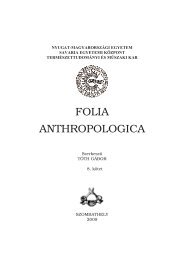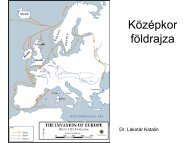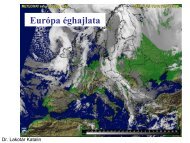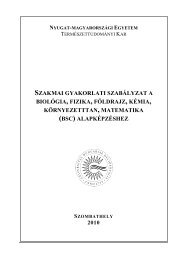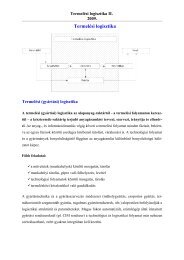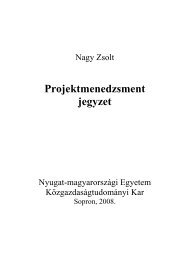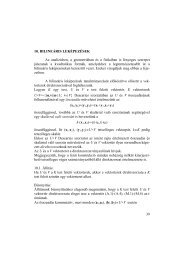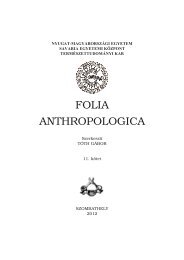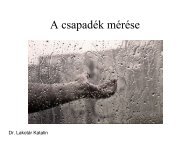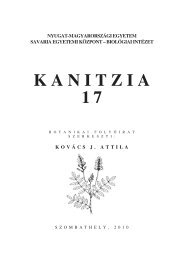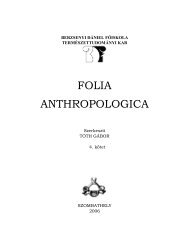Kanitzia 18. - NYME Természettudományi Kar - Nyugat ...
Kanitzia 18. - NYME Természettudományi Kar - Nyugat ...
Kanitzia 18. - NYME Természettudományi Kar - Nyugat ...
You also want an ePaper? Increase the reach of your titles
YUMPU automatically turns print PDFs into web optimized ePapers that Google loves.
americana, Ailanthus altissima, Robinia pseudacacia and Prunus serotina (Miklós Monostori,<br />
László Nagy, Robert W. Pál); Rum, Rába River floodplain: Humulus japonicus,<br />
Echinocystis lobata, Solidago gigantea, Acer negundo, Impatiens glandulifera and Ambrosia<br />
artemisiifolia (Zoltán Botta-Dukát, Ágnes Csiszár, István Dancza, Gyula Pinke);<br />
Körmend, Rába River floodplain: Fallopia ×bohemica (Lajos Balogh; John P. Bailey, UK).<br />
In the followings Attila Lengyel, Attila Mesterházy and Mátyás Szépligeti, then (at Szalafő-<br />
Pityerszer), István Szentirmai and Zsófia Szekeres related about the natural and folklore<br />
values of the Őrség and the Vendvidék. On the way home, Dean László Rátkai provided a<br />
guided tour and blessing in the most renowned Middle Age architectural relic of Vas<br />
County, the Ják church.<br />
Beside the theoretical and practical connections, the attendants were provided<br />
with a valuable insight into Szombathely's and Vas County's cultural life (BALOGH 2011a).<br />
The Hungarian publications concerning the plant invasions could be viewed on site, as<br />
well as two exhibitions of the Szombathely's Savaria Museum: Portraits of Vas County<br />
Natural Scientists, created by the graphic Gyula Simon and the temporary exhibition entitled<br />
Imre Szenczy, the first Hungarian "invasion biologist". (Imre Szenczy, 1789–1860,<br />
was the director and teacher of Szombathely's Praemonstrant Secondary School, one of<br />
the first botanist of Hungary who scientifically related on the plant migrations; 1847.) His<br />
valuable herbarium is kept at the Savaria Museum.)<br />
On the www.emapi2011.org website there are further information and photos as<br />
well as a summary volume and study trip booklet for download (Balogh L.: Plant invasions<br />
typical to Western Hungary – A cross-section in Vas County. Mid-conference field trip.<br />
Excursion guide. 11 th EMAPi, 25 pp., mscr.). Further reports can be read about the 11th<br />
EMAPi on the pages of Vasi Szemle (BALOGH 2011a) and Botanikai Közlemények<br />
(BALOGH 2011b).<br />
As the members of the next generation, pursuing the research of invasive plants,<br />
we are dedicating this conference to the memory of Dr. Szaniszló Priszter, our paragon – not<br />
only because his invaluable professional work but also because of his personality values.<br />
REFERENCES<br />
BALOGH L. (2000): 5 International Conference on the Ecology of Invasive Alien Plants.<br />
La Maddalena (Szardínia), 1999. okt. 13–16. – Múzeumi Hírlevél (Budapest)<br />
21(1): 18–19 (2000. jan.).<br />
BALOGH L. (2002): “Az idegen növényi inváziók ökológiájának és kezelésének 6. nemzetközi<br />
konferenciája” [„6 th International Conference on the Ecology and Manage<br />
ment of Alien Plant Invasions (EMAPi)”], Loughborough, Anglia, 2001. szept.<br />
12–15. – Vasi Szemle (Szombathely) 56(1): 122–123.<br />
BALOGH L. (2011a): Az Özönnövények Ökológiájának és Kezelésének 11. Nemzetközi<br />
Konferenciája [11th International Conference on the Ecology and Management<br />
of Alien Plant Invasions (EMAPi 2011)], Szombathely, 30 th August 2011 – 3 rd<br />
September 2011. – Vasi Szemle 65(5-6): 697–700. www.vasiszemle.t-online.hu<br />
247




